Earlier Spring-Summer Phenology and Higher Photosynthetic Peak Altered the Seasonal Patterns of Vegetation Productivity in Alpine Ecosystems
Abstract
1. Introduction
2. Materials and Methods
2.1. Study Area
2.2. Data Source
2.2.1. Phenological Metrics
2.2.2. Meteorological Data
2.2.3. Gross Primary Productivity Dataset
2.2.4. Other Datasets
2.3. Methods
2.3.1. Maximum Value Composite
2.3.2. Trend Analysis
2.3.3. Pearson Correlation Analysis
3. Results
3.1. Spatio-Temporal Variations of Precipitation and Air Temperature
3.2. Spatio-Temporal Variations of Vegetation Phenology
3.2.1. Spatial Variations
3.2.2. Temporal Variations
3.3. Spatio-Temporal Variations of Seasonal GPP and Annual GPP
3.3.1. Spatial Variations
3.3.2. Temporal Variations
3.4. Relationships between Seasonal GPP and Annual GPP
3.5. Relationships among Climate, Phenology and GPP
3.5.1. Responses of Phenology and GPPmax to Seasonal Precipitation and Air Temperature
3.5.2. Responses of Seasonal and Annual GPP to Phenology Changes
4. Discussion
4.1. Impacts of Phenology and Photosynthetic Capacity on Seasonal GPP
4.2. POS and the Timing of GPPmax
4.3. Uncertainty
5. Conclusions
Author Contributions
Funding
Data Availability Statement
Acknowledgments
Conflicts of Interest
Abbreviations
References
- Anav, A.; Friedlingstein, P.; Beer, C.; Ciais, P.; Harper, A.; Jones, C.; Murray-Tortarolo, G.; Papale, D.; Parazoo, N.C.; Peylin, P.; et al. Spatiotemporal patterns of terrestrial gross primary production: A review. Rev. Geophys. 2015, 53, 785–818. [Google Scholar] [CrossRef]
- Yao, Y.T.; Wang, X.H.; Li, Y.; Wang, T.; Shen, M.G.; Du, M.Y.; He, H.L.; Li, Y.N.; Luo, W.J.; Ma, M.G.; et al. Spatiotemporal pattern of gross primary productivity and its covariation with climate in China over the last thirty years. Glob. Chang. Biol. 2018, 24, 184–196. [Google Scholar] [CrossRef] [PubMed]
- Xia, J.Y.; Niu, S.L.; Ciais, P.; Janssens, I.A.; Chen, J.Q.; Ammann, C.; Arain, A.; Blanken, P.D.; Cescatti, A.; Bonal, D.; et al. Joint control of terrestrial gross primary productivity by plant phenology and physiology. Proc. Natl. Acad. Sci. USA 2015, 112, 2788–2793. [Google Scholar] [CrossRef] [PubMed]
- Zhou, S.; Zhang, Y.; Caylor, K.K.; Luo, Y.Q.; Xiao, X.M.; Ciais, P.; Huang, Y.F.; Wang, G.Q. Explaining inter-annual variability of gross primary productivity from plant phenology and physiology. Agric. For. Meteorol. 2016, 226, 246–256. [Google Scholar] [CrossRef]
- Running, S.W.; Nemani, R.R.; Heinsch, F.A.; Zhao, M.S.; Reeves, M.; Hashimoto, H. A continuous satellite-derived measure of global terrestrial primary production. AIBS Bull. 2004, 54, 547–560. [Google Scholar] [CrossRef]
- Richardson, A.D.; Keenan, T.F.; Migliavacca, M.; Ryu, Y.; Sonnentag, O.; Toomey, M. Climate change, phenology, and phenological control of vegetation feedbacks to the climate system. Agric. For. Meteorol. 2013, 169, 156–173. [Google Scholar] [CrossRef]
- Wu, C.Y.; Hou, X.H.; Peng, D.L.; Gonsamo, A.; Xu, S.G. Land surface phenology of China’s temperate ecosystems over 1999-2013: Spatial-temporal patterns, interaction effects, covariation with climate and implications for productivity. Agric. For. Meteorol. 2016, 216, 177–187. [Google Scholar] [CrossRef]
- Yang, J.L.; Dong, J.W.; Xiao, X.M.; Dai, J.H.; Wu, C.Y.; Xia, J.Y.; Zhao, G.S.; Zhao, M.M.; Li, Z.L.; Zhang, Y.; et al. Divergent shifts in peak photosynthesis timing of temperate and alpine grasslands in China. Remote Sens. Environ. 2019, 233, 111395. [Google Scholar]
- Luo, M.; Meng, F.H.; Sa, C.L.; Duan, Y.C.; Bao, Y.H.; Liu, T.; De Maeyer, P. Response of vegetation phenology to soil moisture dynamics in the Mongolian plateau. Catena 2021, 206, 105505. [Google Scholar] [CrossRef]
- Zhang, T.; Tang, Y.Y.; Xu, M.J.; Zhao, G.; Chen, N.; Zheng, Z.T.; Zhu, J.T.; Ji, X.M.; Wang, D.F.; Zhang, Y.J.; et al. Joint control of alpine meadow productivity by plant phenology and photosynthetic capacity. Agric. For. Meteorol. 2022, 325, 109135. [Google Scholar] [CrossRef]
- Falge, E.; Baldocchi, D.; Tenhunen, J.; Aubinet, M.; Bakwin, P.; Berbigier, P.; Bernhofer, C.; Burba, G.; Clement, R.; Davis, K.J.; et al. Seasonality of ecosystem respiration and gross primary production as derived from FLUXNET measurements. Agric. For. Meteorol. 2002, 113, 53–74. [Google Scholar] [CrossRef]
- Zhang, W.K.; Yu, G.R.; Chen, Z.; Zhang, L.M.; Wang, Q.F.; Zhang, Y.J.; He, H.L.; Han, L.; Chen, S.P.; Han, S.J.; et al. Attribute parameter characterized the seasonal variation of gross primary productivity (αGPP): Spatiotemporal variation and influencing factors. Agric. For. Meteorol. 2020, 280, 107774. [Google Scholar] [CrossRef]
- Zheng, Z.T.; Zhu, W.Q.; Zhang, Y.J. Seasonally and spatially varied controls of climatic factors on net primary productivity in alpine grasslands on the Tibetan Plateau. Glob. Ecol. Conserv. 2020, 21, e00814. [Google Scholar] [CrossRef]
- Piao, S.L.; Ciais, P.; Friedlingstein, P.; Peylin, P.; Reichstein, M.; Luyssaert, S.; Margolis, H.; Fang, J.Y.; Barr, A.; Chen, A.P.; et al. Net carbon dioxide losses of northern ecosystems in response to autumn warming. Nature 2008, 451, 49–52. [Google Scholar] [CrossRef]
- Buermann, W.; Forkel, M.; O’Sullivan, M.; Sitch, S.; Friedlingstein, P.; Haverd, V.; Jain, A.K.; Kato, E.; Kautz, M.; Lienert, S.; et al. Widespread seasonal compensation effects of spring warming on northern plant productivity. Nature 2018, 562, 110–115. [Google Scholar] [CrossRef]
- Zani, D.; Crowther, T.W.; Mo, L.D.; Renner, S.S.; Zohner, C.M. Increased growing-season productivity drives earlier autumn leaf senescence in temperate trees. Science 2020, 370, 1066–1071. [Google Scholar] [CrossRef] [PubMed]
- Yang, L.; Zhao, S.Q. A stronger advance of urban spring vegetation phenology narrows vegetation productivity difference between urban settings and natural environments. Sci. Total Environ. 2023, 868, 161649. [Google Scholar] [CrossRef]
- Steltzer, H.; Post, E. Seasons and Life Cycles. Science 2009, 324, 886–887. [Google Scholar] [CrossRef] [PubMed]
- Ren, S.L.; Peichl, M. Enhanced spatiotemporal heterogeneity and the climatic and biotic controls of autumn phenology in northern grasslands. Sci. Total Environ. 2021, 788, 147806. [Google Scholar] [CrossRef]
- Fang, H.S.; Sha, M.Q.; Xie, Y.C.; Lin, W.J.; Qiu, D.; Tu, J.G.; Tan, X.C.; Li, X.L.; Sha, Z.Y. Shifted global vegetation phenology in response to climate changes and its feedback on vegetation carbon uptake. Remote Sens. 2023, 15, 2288. [Google Scholar] [CrossRef]
- Cheng, M.; Jin, J.X.; Jiang, H. Strong impacts of autumn phenology on grassland ecosystem water use efficiency on the Tibetan Plateau. Ecol. Indic. 2021, 126, 107682. [Google Scholar] [CrossRef]
- Wang, S.Y.; Zhang, B.; Yang, Q.C.; Chen, G.S.; Yang, B.J.; Lu, L.L.; Shen, M.; Peng, Y.Y. Responses of net primary productivity to phenological dynamics in the Tibetan Plateau, China. Agric. For. Meteorol. 2017, 232, 235–246. [Google Scholar] [CrossRef]
- Chen, S.L.; Huang, Y.F.; Gao, S.; Wang, G.Q. Impact of physiological and phenological change on carbon uptake on the Tibetan Plateau revealed through GPP estimation based on spaceborne solar-induced fluorescence. Sci. Total Environ. 2019, 663, 45–59. [Google Scholar] [CrossRef] [PubMed]
- Wilson, D. Variation in leaf respiration in relation to growth and photosynthesis of LOLIUM. Ann. Appl. Biol. 1975, 80, 323–338. [Google Scholar] [CrossRef]
- Wu, C.Y.; Chen, J.M.; Gonsamo, A.; Price, D.T.; Black, T.A.; Kurz, W.A. Interannual variability of net carbon exchange is related to the lag between the end-dates of net carbon uptake and photosynthesis: Evidence from long records at two contrasting forest stands. Agric. For. Meteorol. 2012, 164, 29–38. [Google Scholar] [CrossRef]
- Huang, K.; Xia, J.Y.; Wang, Y.P.; Ahlström, A.; Chen, J.Q.; Cook, R.B.; Cui, E.Q.; Fang, Y.Y.; Fisher, J.B.; Huntzinger, D.N.; et al. Enhanced peak growth of global vegetation and its key mechanisms. Nat. Ecol. Evol. 2018, 2, 1897–1905. [Google Scholar] [CrossRef] [PubMed]
- Wang, X.Y.; Wu, C.Y. Estimating the peak of growing season (POS) of China’s terrestrial ecosystems. Agric. For. Meteorol. 2019, 278, 107639. [Google Scholar] [CrossRef]
- Musavi, T.; Migliavacca, M.; Reichstein, M.; Kattge, J.; Wirth, C.; Black, T.A.; Janssens, I.; Knohl, A.; Loustau, D.; Roupsard, O.; et al. Stand age and species richness dampen interannual variation of ecosystem-level photosynthetic capacity. Nat. Ecol. Evol. 2017, 1, 0048. [Google Scholar] [CrossRef]
- Zhang, J.R.; Xiao, J.F.; Tong, X.J.; Zhang, J.S.; Meng, P.; Li, J.; Liu, P.R.; Yu, P.Y. NIRv and SIF better estimate phenology than NDVI and EVI: Effects of spring and autumn phenology on ecosystem production of planted forests. Agric. For. Meteorol. 2022, 315, 108819. [Google Scholar] [CrossRef]
- Stoy, P.C.; Trowbridge, A.M.; Bauerle, W.L. Controls on seasonal patterns of maximum ecosystem carbon uptake and canopy-scale photosynthetic light response: Contributions from both temperature and photoperiod. Photosynth. Res. 2014, 119, 49–64. [Google Scholar] [CrossRef]
- Zhu, J.T.; Zhang, Y.J.; Jiang, L. Experimental warming drives a seasonal shift of ecosystem carbon exchange in Tibetan alpine meadow. Agric. For. Meteorol. 2017, 233, 242–249. [Google Scholar] [CrossRef]
- Wang, R.; Dong, Z.B.; Zhou, Z.C. Different responses of vegetation to frozen ground degradation in the source region of the Yellow River from 1980 to 2018. Chin. Geogr. Sci. 2020, 30, 557–571. [Google Scholar] [CrossRef]
- Deng, M.S.; Meng, X.H.; Lu, Y.Q.; Shu, L.L.; Li, Z.G.; Zhao, L.; Chen, H.; Shang, L.Y.; Sheng, D.R.; Ao, X.M. Impact of climatic and vegetation dynamic change on runoff over the Three Rivers Source Region based on the Community Land Model. Clim. Dyn. 2023, 61, 1193–1208. [Google Scholar] [CrossRef]
- Iqbal, M.; Wen, J.; Wang, S.P.; Tian, H.; Adnan, M. Variations of precipitation characteristics during the period 1960–2014 in the source region of the Yellow River, China. J. Arid. Land 2018, 10, 388–401. [Google Scholar] [CrossRef]
- Li, S.S.; Gao, Y.H.; Lyu, S.H.; Liu, Y.P.; Pan, Y.J. Response of surface air temperature to the change of leaf area index in the source region of the Yellow River by the WRF model. Theor. Appl. Climatol. 2019, 138, 1755–1765. [Google Scholar] [CrossRef]
- Jin, H.J.; He, R.X.; Cheng, G.D.; Wu, Q.B.; Wang, S.L.; Lu, L.Z.; Chang, X.L. Changes in frozen ground in the source area of the Yellow River on the Qinghai-Tibet Plateau, China, and their eco-environmental impacts. Environ. Res. Lett. 2009, 4, 045206. [Google Scholar] [CrossRef]
- Wang, T.H.; Yang, D.W.; Qin, Y.; Wang, Y.H.; Chen, Y.; Gao, B.; Yang, H.B. Historical and future changes of frozen ground in the upper Yellow River Basin. Glob. Planet. Chang. 2018, 162, 199–211. [Google Scholar] [CrossRef]
- Liu, X.Y.; Liu, C.; Fan, B.H.; Li, L.G.; Tan, B.; Jin, Z.W.; Lu, H.; Liu, T.G. Spatial responses of ecosystem water-use efficiency to hydrothermal and vegetative gradients in alpine grassland ecosystem in drylands. Ecol. Indic. 2022, 141, 109064. [Google Scholar] [CrossRef]
- Xue, B.L.; Wang, L.; Li, X.P.; Yang, K.; Chen, D.L.; Sun, L.T. Evaluation of evapotranspiration estimates for two river basins on the Tibetan Plateau by a water balance method. J. Hydrol. 2013, 492, 290–297. [Google Scholar] [CrossRef]
- Liu, J.; Chen, J.J.; Qin, Q.T.; You, H.T.; Han, X.W.; Zhou, G.Q. Patch pattern and ecological risk assessment of alpine grassland in the source region of the Yellow River. Remote Sens. 2020, 12, 3460. [Google Scholar] [CrossRef]
- Jiang, Z.Y.; Huete, A.R.; Didan, K.; Miura, T. Development of a two-band enhanced vegetation index without a blue band. Remote Sens. Environ. 2008, 112, 3833–3845. [Google Scholar] [CrossRef]
- Jia, W.X.; Zhao, S.Q.; Zhang, X.Y.; Liu, S.G.; Henebry, G.M.; Liu, L.L. Urbanization imprint on land surface phenology: The urban-rural gradient analysis for Chinese cities. Glob. Chang. Biol. 2021, 27, 2895–2904. [Google Scholar] [CrossRef]
- Ren, S.L.; Vitasse, Y.; Chen, X.Q.; Peichl, M.; An, S. Assessing the relative importance of sunshine, temperature, precipitation, and spring phenology in regulating leaf senescence timing of herbaceous species in China. Agric. For. Meteorol. 2022, 313, 108770. [Google Scholar] [CrossRef]
- Gonsamo, A.; Chen, J.M.; Ooi, Y.W. Peak season plant activity shift towards spring is reflected by increasing carbon uptake by extratropical ecosystems. Glob. Chang. Biol. 2018, 24, 2117–2128. [Google Scholar] [CrossRef]
- Ji, Z.X.; Pei, T.T.; Chen, Y.; Wu, H.W.; Hou, Q.Q.; Shi, F.Z.; Xie, B.P.; Zhang, J.X. The driving factors of grassland water use efficiency along degradation gradients on the Qinghai-Tibet Plateau, China. Glob. Ecol. Conserv. 2022, 35, e02090. [Google Scholar] [CrossRef]
- Lian, X.; Piao, S.L.; Li, L.Z.X.; Li, Y.; Huntingford, C.; Ciais, P.; Cescatti, A.; Janssens, I.A.; Penuelas, J.; Buermann, W.; et al. Summer soil drying exacerbated by earlier spring greening of northern vegetation. Sci. Adv. 2020, 6, eaax0255. [Google Scholar] [CrossRef]
- Huang, K.; Zhang, Y.J.; Tagesson, T.; Brandt, M.; Wang, L.H.; Chen, N.; Zu, J.X.; Jin, H.X.; Cai, Z.Z.; Tong, X.W.; et al. The confounding effect of snow cover on assessing spring phenology from space: A new look at trends on the Tibetan Plateau. Sci. Total Environ. 2021, 756, 144011. [Google Scholar] [CrossRef] [PubMed]
- Ma, D.J.; Wu, X.D.; Ma, X.L.; Wang, J.P.; Lin, X.W.; Mu, C.C. Spatial, phenological, and inter-Annual variations of gross primary productivity in the Arctic from 2001 to 2019. Remote Sens. 2021, 13, 2875. [Google Scholar] [CrossRef]
- Wang, J.Y.; Sun, H.Z.; Xiong, J.N.; He, D.; Cheng, W.M.; Ye, C.C.; Yong, Z.W.; Huang, X.L. Dynamics and drivers of vegetation phenology in Three-River headwaters region based on the Google Earth Engine. Remote Sens. 2021, 13, 2528. [Google Scholar] [CrossRef]
- Editorial Board of Vegetation Map of China; Chinese Academy of Sciences. Vegetation Map of the People’s Republic of China (1:1,000,000) (Digital Version); Geology Press: Beijing, China, 2007. [Google Scholar]
- Holben, B.N. Characteristics of maximum-value composite images from temporal AVHRR data. Int. J. Remote Sens. 1986, 7, 1417–1434. [Google Scholar] [CrossRef]
- Environmental Systems Research Institute (ESRI). ArcGIS Desktop: Release 10.6; Environmental Systems Research Institute (ESRI): Redlands, CA, USA, 2018; Available online: https://www.esri.com (accessed on 20 January 2020).
- Sen, P.K. Estimates of the regression coeffcient based on Kendall’s tau. J. Am. Stat. Assoc. 1968, 63, 1379–1389. [Google Scholar] [CrossRef]
- Mann, H.B. Nonparametric tests against trend. Econometrica 1945, 13, 245–259. [Google Scholar] [CrossRef]
- Kendall, M.G. Rank Correlation Measures; Charles Griffin: London, UK, 1975. [Google Scholar]
- The MathWorks, Inc. MATLAB, Version 2018b; The MathWorks, Inc.: Natick, MA, USA, 2018. Available online: https://www.mathworks.com (accessed on 4 February 2020).
- Zhang, J.R.; Gonsamo, A.; Tong, X.J.; Xiao, J.F.; Rogers, C.A.; Qin, S.H.; Liu, P.R.; Yu, P.Y.; Ma, P. Solar-induced chlorophyll fluorescence captures photosynthetic phenology better than traditional vegetation indices. ISPRS J. Photogramm. Remote Sens. 2023, 203, 183–198. [Google Scholar] [CrossRef]
- Sun, H.Z.; Chen, Y.B.; Xiong, J.N.; Ye, C.H.; Yong, Z.W.; Wang, Y.; He, D.; Xu, S.C. Relationships between climate change, phenology, edaphic factors, and net primary productivity across the Tibetan Plateau. Int. J. Appl. Earth Obs. Geoinf. 2022, 107, 102708. [Google Scholar] [CrossRef]
- Zu, J.X.; Zhang, Y.J.; Huang, K.; Liu, Y.J.; Chen, N.; Cong, N. Biological and climate factors co-regulated spatial-temporal dynamics of vegetation autumn phenology on the Tibetan Plateau. Int. J. Appl. Earth Obs. Geoinf. 2018, 69, 198–205. [Google Scholar] [CrossRef]
- Shen, M.G.; Wang, S.P.; Jiang, N.; Sun, J.P.; Cao, R.Y.; Ling, X.F.; Fang, B.; Zhang, L.; Zhang, L.H.; Xu, X.Y.; et al. Plant phenology changes and drivers on the Qinghai-Tibetan Plateau. Nat. Rev. Earth Environ. 2022, 3, 633–651. [Google Scholar] [CrossRef]
- Shen, X.J.; Xue, Z.S.; Jiang, M.; Lu, X.G. Spatiotemporal change of vegetation coverage and its Relationship with climate change in freshwater marshes of northeast China. Wetlands 2019, 39, 429–439. [Google Scholar] [CrossRef]
- Cheng, M.; Wang, Y.; Zhu, J.X.; Pan, Y. Precipitation dominates the relative contributions of climate factors to grasslands spring phenology on the Tibetan Plateau. Remote Sens. 2022, 14, 517. [Google Scholar] [CrossRef]
- Shi, C.G.; Sun, G.; Zhang, H.X.; Xiao, B.X.; Ze, B.; Zhang, N.N.; Wu, N. Effects of warming on chlorophyll degradation and carbohydrate accumulation of alpine herbaceous species during plant senescence on the Tibetan Plateau. PLoS ONE 2014, 9, e107874. [Google Scholar] [CrossRef] [PubMed]
- Liu, Q.; Fu, Y.S.H.; Zeng, Z.Z.; Huang, M.T.; Li, X.R.; Piao, S.L. Temperature, precipitation, and insolation effects on autumn vegetation phenology in temperate China. Glob. Chang. Biol. 2016, 22, 644–655. [Google Scholar] [CrossRef] [PubMed]
- Gill, A.L.; Gallinat, A.S.; Sanders-DeMott, R.; Rigden, A.J.; Gianotti, D.J.S.; Mantooth, J.A.; Templer, P.H. Changes in autumn senescence in northern hemisphere deciduous trees: A meta-analysis of autumn phenology studies. Ann. Bot. 2015, 116, 875–888. [Google Scholar] [CrossRef]
- Zheng, Z.T.; Zhu, W.Q.; Zhang, Y.J. Direct and lagged effects of spring phenology on net primary productivity in the alpine grasslands on the Tibetan Plateau. Remote Sens. 2020, 12, 1223. [Google Scholar] [CrossRef]
- Li, X.Y.; Zhao, C.Z.; Kang, M.P.; Ma, M. Responses of net primary productivity to phenological dynamics based on a data fusion algorithm in the northern Qinghai-Tibet Plateau. Ecol. Indic. 2022, 142, 109239. [Google Scholar] [CrossRef]
- Turner, D.P.; Ritts, W.D.; Cohen, W.B.; Gower, S.T.; Zhao, M.S.; Running, S.W.; Wofsy, S.C.; Urbanski, S.; Dunn, A.L.; Munger, J.W. Scaling Gross Primary Production (GPP) over boreal and deciduous forest landscapes in support of MODIS GPP product validation. Remote Sens. Environ. 2003, 88, 256–270. [Google Scholar] [CrossRef]
- Kim, J.H.; Hwang, T.; Yang, Y.; Schaaf, C.L.; Boose, E.; Munger, J.W. Warming-induced earlier greenup leads to reduced stream discharge in a temperate mixed forest catchment. J. Geophys. Res. Biogeosci. 2018, 123, 1960–1975. [Google Scholar] [CrossRef]
- Jin, J.X.; Wang, Y.; Zhang, Z.; Magliulo, V.; Jiang, H.; Cheng, M. Phenology plays an important role in the regulation of terrestrial ecosystem water-use efficiency in the Northern Hemisphere. Remote Sens. 2017, 9, 664. [Google Scholar] [CrossRef]
- Yu, Z.; Lu, C.Q.; Cao, P.Y.; Tian, H.Q.; Hessl, A.; Pederson, N. Earlier leaf-flushing suppressed ecosystem productivity by draining soil water in the Mongolian Plateau. Agric. For. Meteorol. 2018, 250, 1–8. [Google Scholar] [CrossRef]
- Park, T.; Chen, C.; Macias-Fauria, M.; Tommervik, H.; Choi, S.; Winkler, A.; Bhatt, U.S.; Walker, D.A.; Piao, S.L.; Brovkin, V.; et al. Changes in timing of seasonal peak photosynthetic activity in northern ecosystems. Glob. Chang. Biol. 2019, 25, 2382–2395. [Google Scholar] [CrossRef] [PubMed]
- Xu, C.Y.; Liu, H.Y.; Williams, A.P.; Yin, Y.; Wu, X.C. Trends toward an earlier peak of the growing season in Northern Hemisphere mid-latitudes. Glob. Chang. Biol. 2016, 22, 2852–2860. [Google Scholar] [CrossRef]
- Ge, Z.X.; Huang, J.; Wang, X.F.; Tang, X.G.; Fan, L.; Zhao, Y.J.; Ma, M.G. Contrasting trends between peak photosynthesis timing and peak greenness timing across seven typical biomes in Northern Hemisphere mid-latitudes. Agric. For. Meteorol. 2022, 323, 12. [Google Scholar] [CrossRef]
- Xu, X.J.; Du, H.Q.; Fan, W.L.; Hu, J.G.; Mao, F.J.; Dong, H. Long-term trend in vegetation gross primary production, phenology and their relationships inferred from the FLUXNET data. J. Environ. Manag. 2019, 246, 605–616. [Google Scholar] [CrossRef] [PubMed]
- Wu, C.Y.; Peng, D.L.; Soudani, K.; Siebicke, L.; Gough, C.M.; Arain, M.A.; Bohrer, G.; Lafleur, P.M.; Peichl, M.; Gonsamo, A.; et al. Land surface phenology derived from normalized difference vegetation index (NDVI) at global FLUXNET sites. Agric. For. Meteorol. 2017, 233, 171–182. [Google Scholar] [CrossRef]
- Wu, L.Z.; Ma, X.F.; Dou, X.; Zhu, J.T.; Zhao, C.Y. Impacts of climate change on vegetation phenology and net primary productivity in arid Central Asia. Sci. Total Environ. 2021, 796, 149055. [Google Scholar] [CrossRef]
- Ma, X.L.; Zhu, X.L.; Xie, Q.Y.; Jin, J.X.; Zhou, Y.K.; Luo, Y.P.; Liu, Y.X.; Tian, J.Q.; Zhao, Y.H. Monitoring nature’s calendar from space: Emerging topics in land surface phenology and associated opportunities for science applications. Glob. Chang. Biol. 2022, 28, 7186–7204. [Google Scholar] [CrossRef] [PubMed]
- Nayak, R.K.; Patel, N.R.; Dadhwal, V.K. Estimation and analysis of terrestrial net primary productivity over India by remote-sensing-driven terrestrial biosphere model. Environ. Monit. Assess. 2010, 170, 195–213. [Google Scholar] [CrossRef] [PubMed]
- He, H.L.; Liu, M.; Xiao, X.M.; Ren, X.L.; Zhang, L.; Sun, X.M.; Yang, Y.H.; Li, Y.N.; Zhao, L.; Shi, P.L.; et al. Large-scale estimation and uncertainty analysis of gross primary production in Tibetan alpine grasslands. J. Geophys. Res. Biogeosci. 2014, 119, 466–486. [Google Scholar] [CrossRef]
- Tu, Z.Q.; Sun, Y.; Wu, C.Y.; Ding, Z.; Tang, X.G. Long-term dynamics of peak photosynthesis timing and environmental controls in the Tibetan Plateau monitored by satellite solar-induced chlorophyll fluorescence. Int. J. Digit. Earth 2024, 17, 2300311. [Google Scholar] [CrossRef]
- Zhao, D.Y.; Hou, Y.Q.; Zhang, Z.Y.; Wu, Y.F.; Zhang, X.K.; Wu, L.S.; Zhu, X.L.; Zhang, Y.G. Temporal resolution of vegetation indices and solar-induced chlorophyll fluorescence data affects the accuracy of vegetation phenology estimation: A study using in-situ measurements. Ecol. Indic. 2022, 136, 108673. [Google Scholar] [CrossRef]
- Wang, S.Y.; Wang, X.Y.; Chen, G.S.; Yang, Q.C.; Wang, B.; Ma, Y.X.; Shen, M. Complex responses of spring alpine vegetation phenology to snow cover dynamics over the Tibetan Plateau, China. Sci. Total Environ. 2017, 593, 449–461. [Google Scholar] [CrossRef]
- Gao, B.; Li, J.; Wang, X.S. Impact of frozen soil changes on vegetation phenology in the source region of the Yellow River from 2003 to 2015. Theor. Appl. Climatol. 2020, 141, 1219–1234. [Google Scholar] [CrossRef]
- Wang, Y.Y.; Ma, Y.M.; Li, H.X.; Yuan, L. Carbon and water fluxes and their coupling in an alpine meadow ecosystem on the northeastern Tibetan Plateau. Theor. Appl. Climatol. 2020, 142, 1–18. [Google Scholar] [CrossRef]
- Zhang, Q.; Zhao, H.F.; Cheng, W.Y.; Cong, N.; Wang, X.H.; Liang, H.Q.; Li, X. Ncreased productivity of temperate vegetation in the preceding year drives early spring phenology in the subsequent year in northern China. Sci. Total Environ. 2023, 903, 166676. [Google Scholar] [CrossRef] [PubMed]
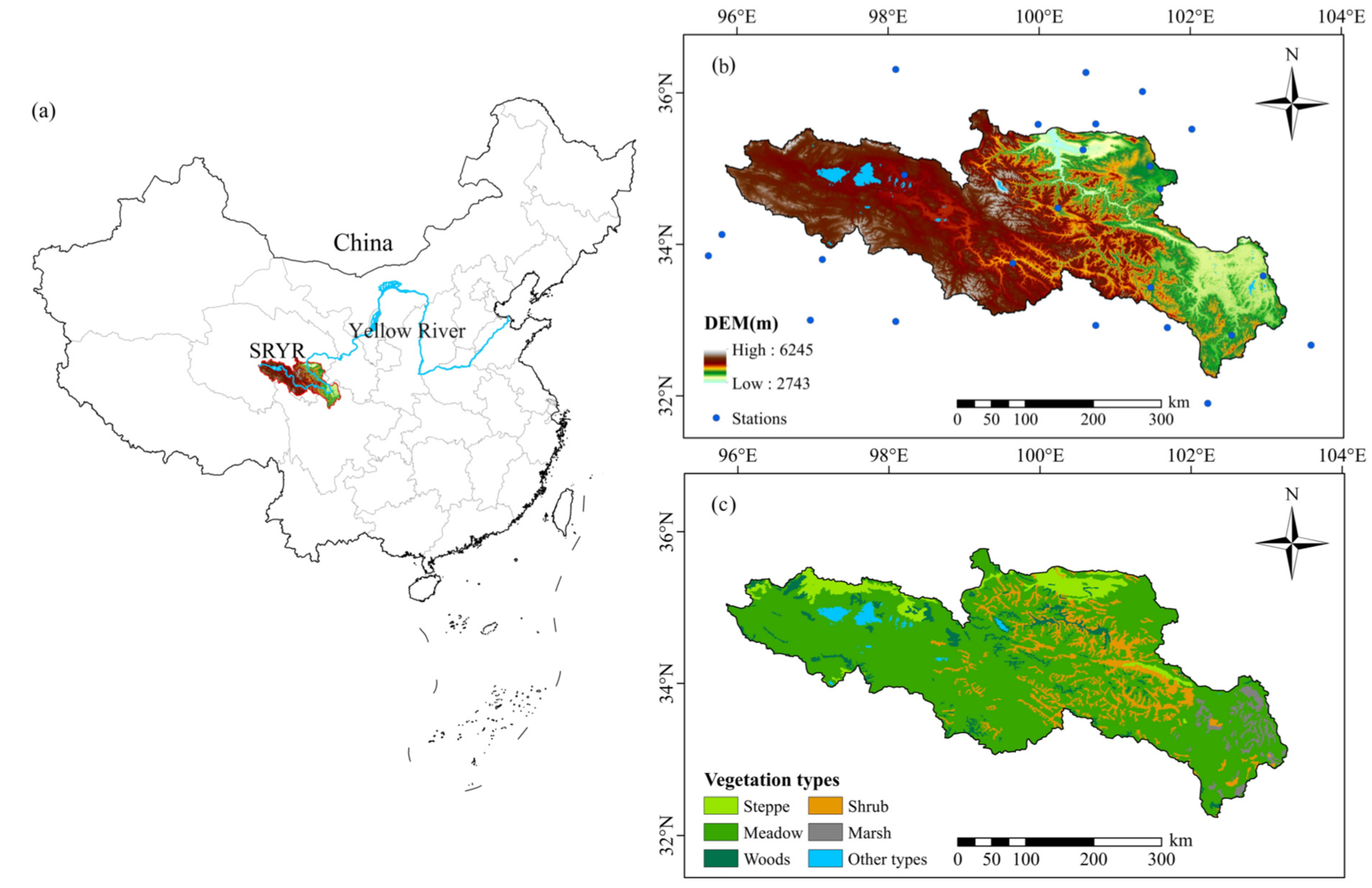
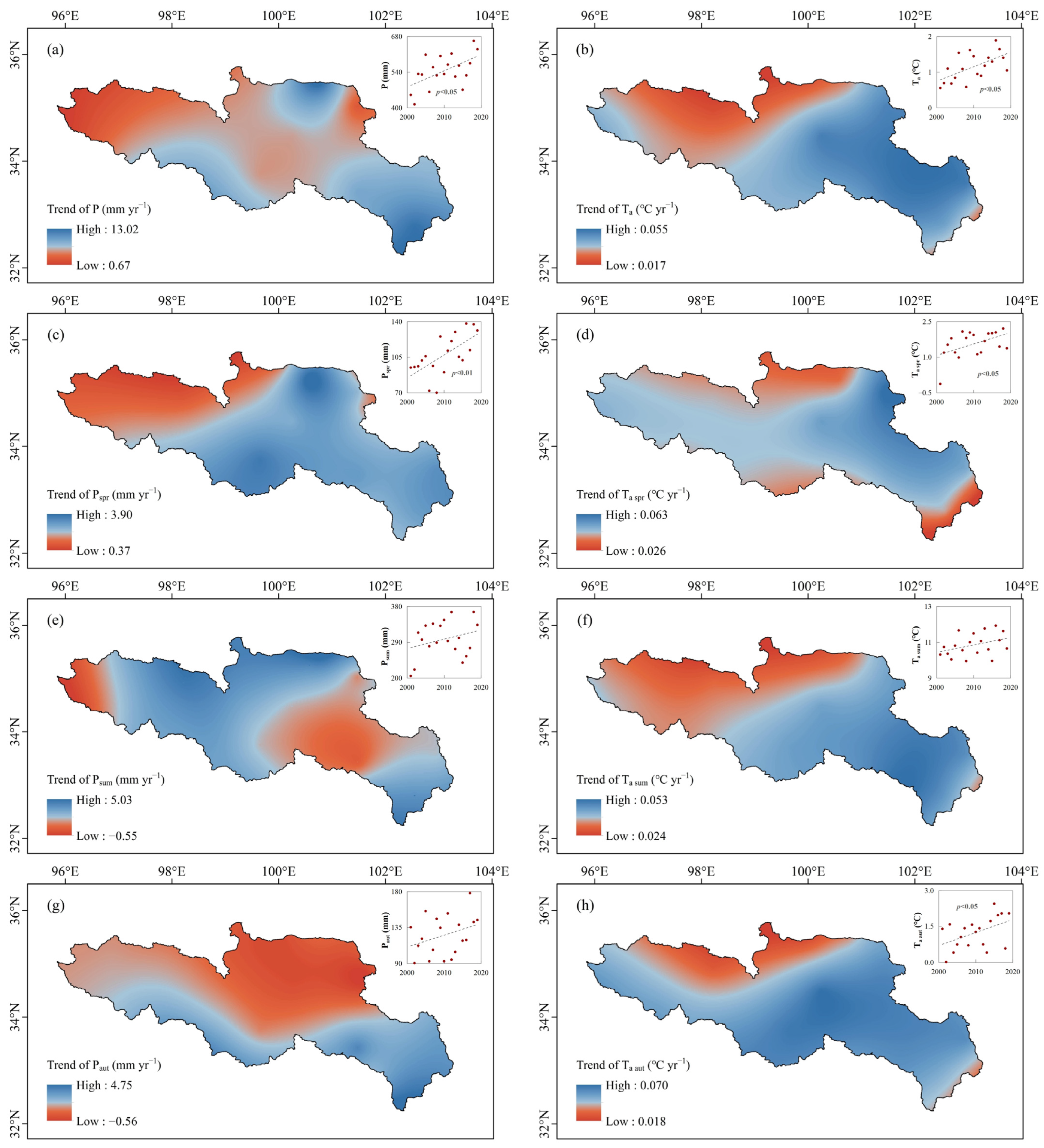
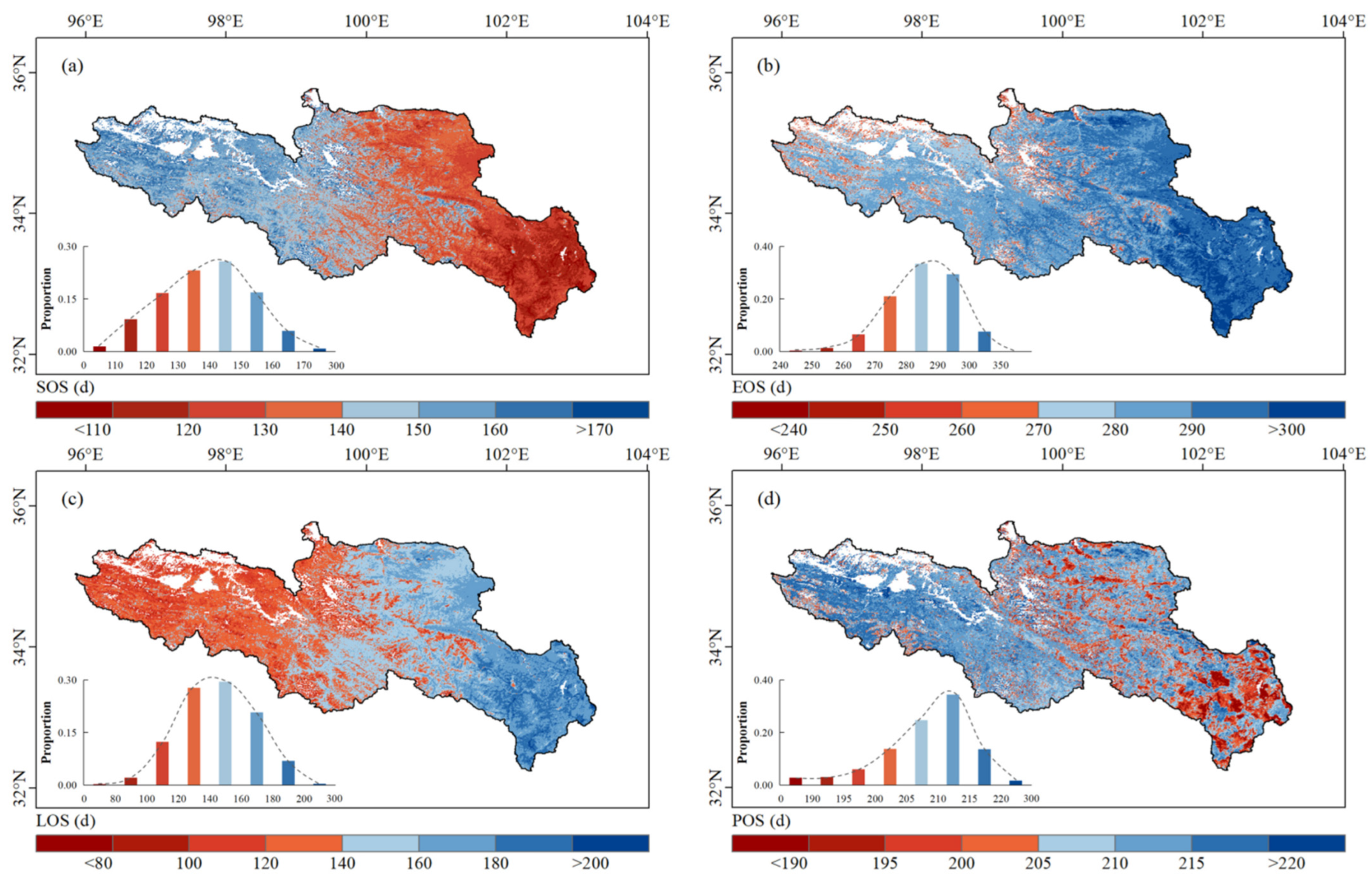
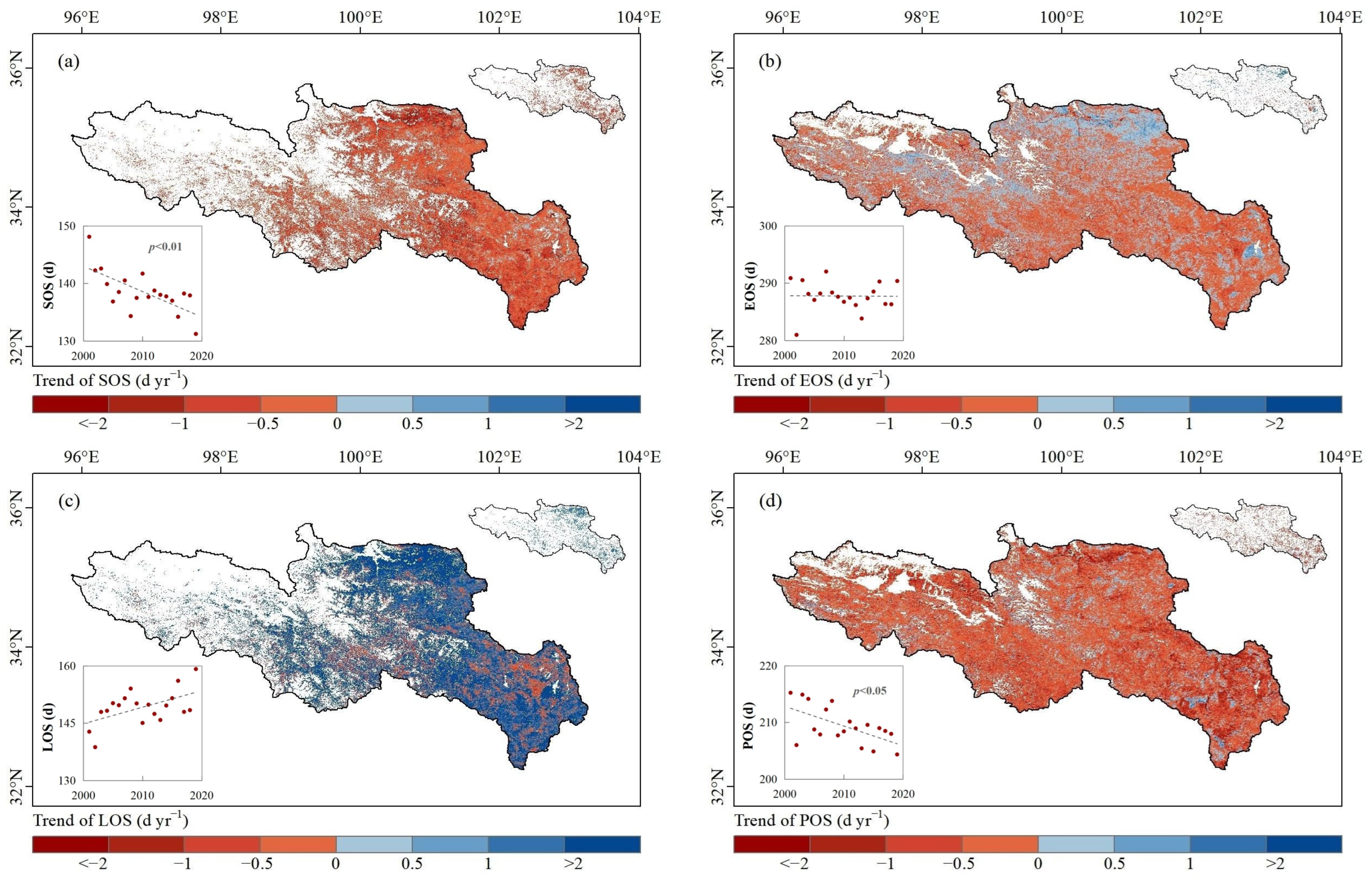

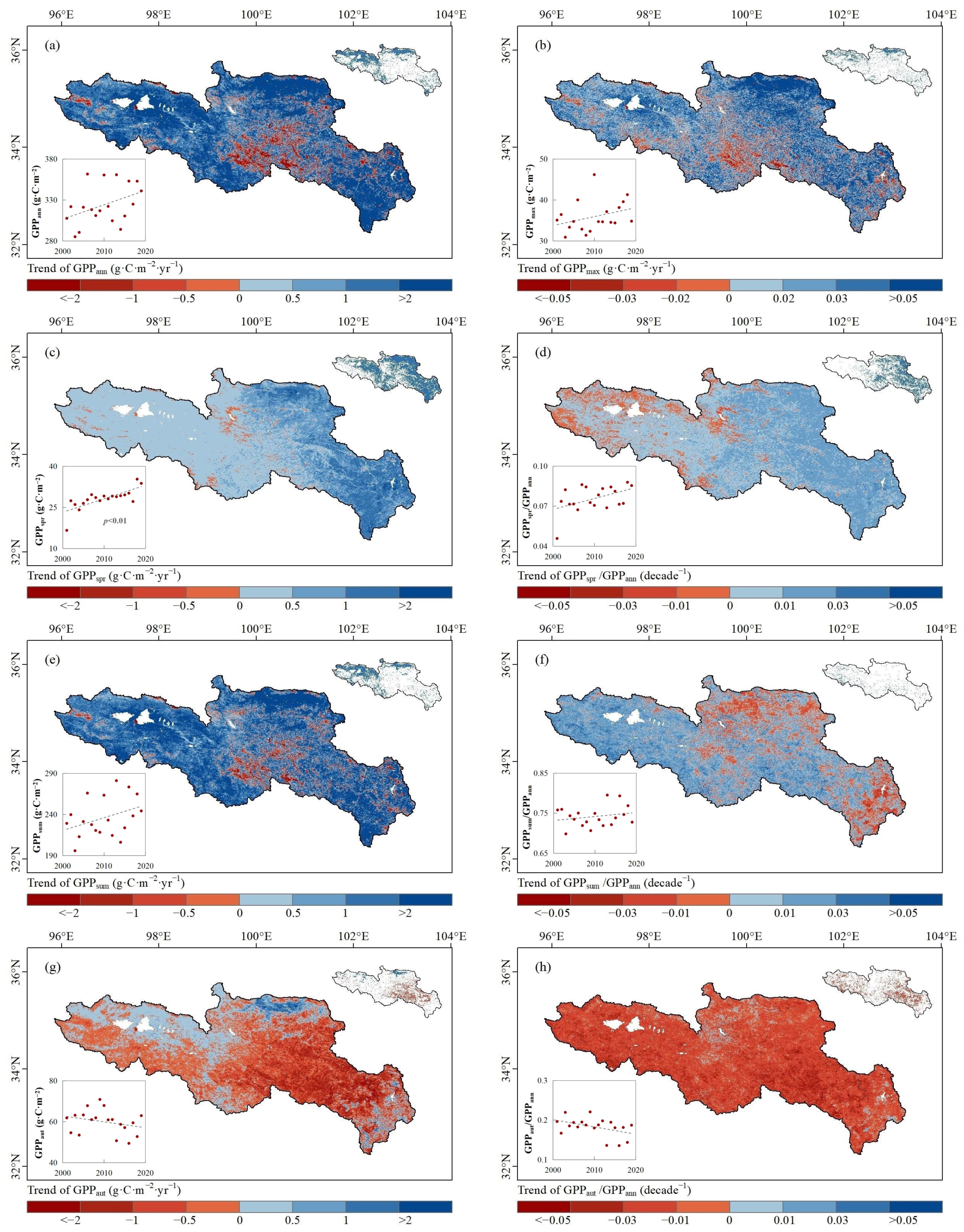
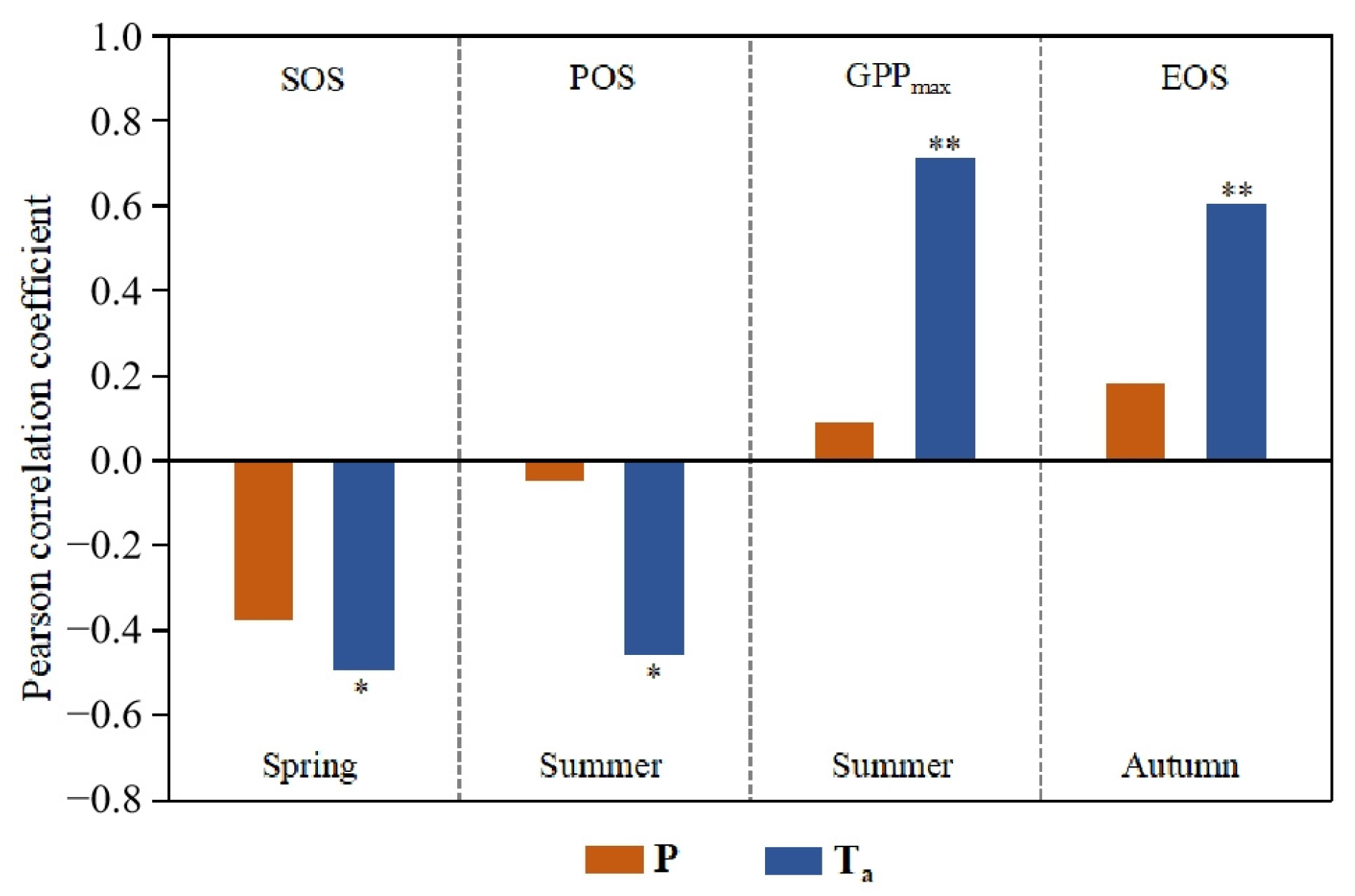


| Station | Lon (°) | Lat (°) | Elevation (m) |
|---|---|---|---|
| Aba | 101.70 | 32.90 | 3275.1 |
| Zeku | 101.47 | 35.03 | 3662.8 |
| Hongyuan | 102.55 | 32.80 | 3491.6 |
| Ruoergai | 102.97 | 33.58 | 3441.4 |
| Maduo | 98.22 | 34.92 | 4272.3 |
| Dari | 99.65 | 33.75 | 3967.5 |
| Xinghai | 99.98 | 35.58 | 3323.2 |
| Henan | 101.60 | 34.73 | 3500.0 |
| Tongde | 100.58 | 35.25 | 3148.2 |
| Maerkang | 102.23 | 31.90 | 2664.4 |
| Shiqu | 98.10 | 32.98 | 4200.0 |
| Tongren | 102.02 | 35.52 | 2491.4 |
| Jiuzhi | 101.48 | 33.43 | 3628.5 |
| Qingshuihe | 97.13 | 33.80 | 4415.4 |
| Banma | 100.75 | 32.93 | 3530.0 |
| Dulan | 98.10 | 36.31 | 3189.0 |
| Qumalai | 95.80 | 34.13 | 4175.0 |
| Maqin | 100.25 | 34.48 | 3719.0 |
| Guinan | 100.75 | 35.59 | 3120.0 |
| Gonghe | 100.62 | 36.27 | 2835.0 |
| Guide | 101.37 | 36.02 | 2237.1 |
| Zhiduo | 95.62 | 33.85 | 4179.1 |
| Yushu | 96.97 | 33.00 | 3716.9 |
| Songpan | 103.60 | 32.67 | 2850.7 |
| Pattern | GPPann | GPPspr | GPPsum | GPPaut | Area Proportion |
|---|---|---|---|---|---|
| I | + | + | + | − | 51.79% |
| II | + | + | + | + | 32.32% |
| III | − | + | − | − | 7.75% |
| IV | − | + | + | − | 3.48% |
| V | + | − | + | − | 1.31% |
| VI | + | − | + | + | 0.93% |
Disclaimer/Publisher’s Note: The statements, opinions and data contained in all publications are solely those of the individual author(s) and contributor(s) and not of MDPI and/or the editor(s). MDPI and/or the editor(s) disclaim responsibility for any injury to people or property resulting from any ideas, methods, instructions or products referred to in the content. |
© 2024 by the authors. Licensee MDPI, Basel, Switzerland. This article is an open access article distributed under the terms and conditions of the Creative Commons Attribution (CC BY) license (https://creativecommons.org/licenses/by/4.0/).
Share and Cite
Yang, F.; Liu, C.; Chen, Q.; Lai, J.; Liu, T. Earlier Spring-Summer Phenology and Higher Photosynthetic Peak Altered the Seasonal Patterns of Vegetation Productivity in Alpine Ecosystems. Remote Sens. 2024, 16, 1580. https://doi.org/10.3390/rs16091580
Yang F, Liu C, Chen Q, Lai J, Liu T. Earlier Spring-Summer Phenology and Higher Photosynthetic Peak Altered the Seasonal Patterns of Vegetation Productivity in Alpine Ecosystems. Remote Sensing. 2024; 16(9):1580. https://doi.org/10.3390/rs16091580
Chicago/Turabian StyleYang, Fan, Chao Liu, Qianqian Chen, Jianbin Lai, and Tiegang Liu. 2024. "Earlier Spring-Summer Phenology and Higher Photosynthetic Peak Altered the Seasonal Patterns of Vegetation Productivity in Alpine Ecosystems" Remote Sensing 16, no. 9: 1580. https://doi.org/10.3390/rs16091580
APA StyleYang, F., Liu, C., Chen, Q., Lai, J., & Liu, T. (2024). Earlier Spring-Summer Phenology and Higher Photosynthetic Peak Altered the Seasonal Patterns of Vegetation Productivity in Alpine Ecosystems. Remote Sensing, 16(9), 1580. https://doi.org/10.3390/rs16091580








